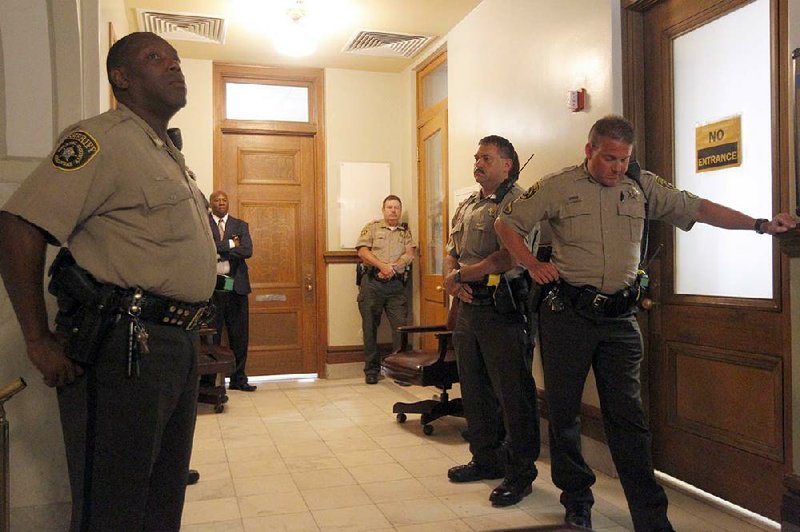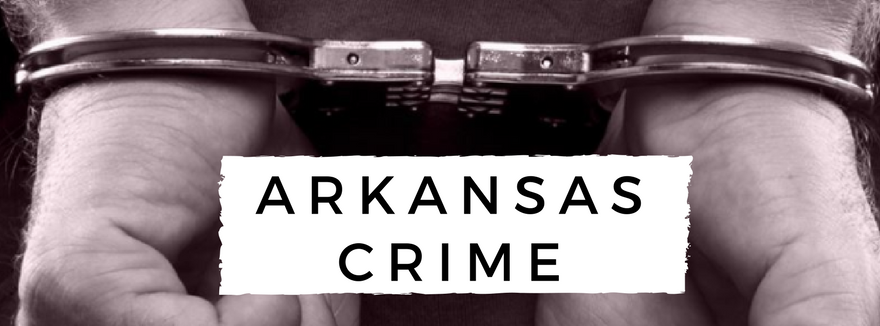The manslaughter trial of fired Little Rock police officer Josh Hastings ended in mistrial Sunday after jurors deliberated a second day for about five hours but were unable to reach the required unanimous verdict.
Document set
Josh Hastings trial accident reports
And while that outcome leaves the 27-year-old Benton resident a free man until he can be tried again in the fall, his attorney, Bill James, was held in contempt and fined $25,000 by Pulaski County Circuit Judge Wendell Griffen for violating the judge’s rules regarding how two teenage witnesses, Jeremiah Johnson and Keontay Walker, could be questioned about their juvenile criminal records.
Citing state confidentiality laws for juvenile records considered in light of a U.S. Supreme Court ruling on questioning child witnesses, Griffen had restricted the defense from invoking the records of the teens who were in the car with 15-year-old Bobby Joe “Weedy” Moore III when he was killed. The prohibition barred James from invoking Moore’s teenage passengers’ criminal history in a manner that suggested their pasts could be considered an indication of how they behaved the night of the shooting.
James violated his order, Griffen said after jurors had been released, in the defense opening statement, cross-examination of the boys and in closing arguments. The judge, reading from the transcript of James questioning the boys, ticked off eight instances of inappropriate questions- typically when James was asking one of the teens about whether they were worried about getting caught that night - and imposed a $2,500 contempt fine for each of the 10 total instances.
The judge said he had amply described the circumstances under which James could question the teens about their criminal history and also clearly described the penalty for breaking the rule. James’ violations were repeated so often, Griffen said, he could see they were deliberate.
“I expect better of lawyers in this court,” the judge said.
The judge said he had considered a five-day jail term for each violation but decided against it because he was confident that James would learn his lesson. Also, the judge said, Hastings needs James free to prepare for his next trial, set for three weeks in September, and a 40-day jail term for contempt would force a delay in his next trial.
“I think a fine will be sufficient. You can prove me wrong. I hope you don’t.” Griffen said. “When I rule, you obey.”
Hastings was charged with manslaughter for killing Moore, the driver of a car Hastings said was going to run over him as the officer investigated car break-ins in August at a west Little Rock apartment complex. Police and prosecutors contended he acted recklessly after an investigation failed to support Hastings’ version of events. Hastings, who was fired in part for the shooting, said he had to shoot to save himself when the vehicle came at him.
To convict on manslaughter, jurors were required to unanimously agree on that count. If they could all agree to reject that charge, then jurors were required to consider the lesser count of misdemeanor negligent homicide, but if they were unanimous in deciding he was also innocent of that charge, then they would have to acquit him. The differences between jurors could not be ascertained Sunday afternoon. Two jurors approached by a reporter after the judge excused them declined to comment, and other jurors could not be found.
But juror notes, released after the trial, show that the nine women and three men indicated they were deadlocked after they had spent about five hours together on Saturday, their first day of deliberation.
With a manslaughter conviction resting on the jurors’ decision on whether Hastings acted without properly considering the risks of what he was doing, jurors wanted to know when he could be considered to have engaged in prohibited dangerous behavior. Was it when he decided to fire his gun or when he actually fired it, jurors asked in their note.
With the judge prohibited from providing further guidance, Griffen responded that they should consult the written instructions he had given them when he sent them to begin deliberations.
About 30 minutes later, jurors signaled again they were still not able to agree.
“We have jurors in support of all three verdict options despite hours of discussion,” the juror note states.
The judge’s response, written after consulting with both sides, encouraged jurors to continue working, but another note from the jury, sent out about 75 minutes later, stated that they were still in disagreement.
“Votes of jurors support all three verdicts,” the three-line note states, and the judge dismissed the panel for the day 15 minutes later.
On Sunday, Griffen sent jurors to resume deliberations at noon after reading them the “dynamite instruction,” which is an exhortation given to deadlocked jurors to continue to work toward a verdict. Within a few minutes of being sent into the jury room, jurors requested a dry-erase board and some markers, which were provided, and the legal definition of “unjustifiable risk,” which was not.
In his response, the judge said all of the legal definitions they were entitled to were contained in the written instructions that he had given to them after closing arguments.
“You have received instructions that contain the definitions which govern this case. You are directed to fulfill your oath and follow these instructions,” Griffen wrote.
Jurors reported in a second note about three hours later that they were still divided, but also “still deliberating the opposing viewpoints.”
“Are you hopelessly deadlocked?” Griffen responded.
“We are not, at this time, hopelessly deadlocked” was the response.
However, when called from the jury room about 90 minutes after that note and questioned by the judge in open court about the possibility of reaching a decision, the jury foreman said a unanimous verdict was “possible” but “It would be difficult.” Griffen then declared a mistrial, commended them for their work and stood up as a salute to their service as they left.
“You are patriots,” he told them.
The response to the mistrial was muted in court, likely because Griffen regularly warned spectators that any outbursts or disturbances would be grounds for immediate arrest.
Outside the courthouse Sunday, a group of spectators complained that an all-white jury had been seated to hear a criminal case against a white police officer who had killed a black teenager.
The Hastings case is the first time a Little Rock officer has stood trial over allegations of violent line-of-duty misconduct since January 1996, when two Little Rock police officers were acquitted at trial over accusations they beat and pepper-sprayed a woman they had abducted off the street in their patrol car a year earlier. The defense contended the woman was a drug-addicted prostitute and habitual liar. Jurors in that case deliberated about two hours to reject the kidnapping and misdemeanor battery charges against the men.
Like Hastings, they had been fired from the department before trial and their efforts to get their jobs back, including a lawsuit, were unsuccessful.
During the seven-day trial, the prosecution and defense together introduced 128 pieces of evidence, mostly photographs of the car, the site of the shooting and the embankment, but also including Hastings’ pistol, the recovered shell casings, bullets from Moore’s body, recordings of a 911 call and police radio broadcasts, as well as written reports from defense and prosecution accident-reconstruction experts.
Jurors also heard from 11 state witnesses, including three police officers and the two boys in the car with Moore, while the defense called five witnesses besides the defendant, including Jessica Miller, the apartment tenant whose 911 call brought police to the scene, and two other officers. James also played Miller’s call to police, as well as a 2 ½ -minute excerpt of police broadcast from the night of the killing with a winded and sometimes emotional Hastings calling out “shots fired” over the radio to fellow officers and seconds later calling for an ambulance for Moore.
With the proceedings running longer than the scheduled four days - prompting Sunday’s almost unprecedented session - both prosecutors and defense dropped witnesses they had told jurors they were calling to try and conclude the trial sooner. For prosecutors, the witness was a police training officer whose testimony they said would contradict Hastings’ claim that the way he said he held his gun that night was an approved police tactic. Hastings said a painful hand injury prevents him from holding his pistol at a straight 90 degrees but that he has permission to angle his gun hand slightly to the left.
The defense dropped plans to recall two police detectives whose reports the defense had called into question in opening statements, saying those officers in their reports had attributed statements to the two teens that the boys had not made.
Evidence prosecutors contended particularly revealing were photographs of Moore in the car. The teen was in a white shirt and light red shorts, with calf-high red socks, leaning to the side in the drivers seat. Photographs showed his left foot was next to the brake, and the steering wheel appeared to be turned to the right, with the blood-daubed gear shift in neutral. Moore had been wearing slip-on Nike sandals, but the right sandal was resting on the brake pedal while his right foot was next to the gas pedal.
The biggest difference between the sides - which prosecutors said was sure proof that Hastings was guilty - was the question of what the car did when Moore was shot. The teen’s head wound was immediately fatal, and Hastings said the vehicle continued to move toward him and neither gained speed nor slowed down. He said he somehow got out of the way after shooting and the vehicle drove up a rocky embankment behind him, then rolled back down the hill about 200 feet where it crashed into another car and a pole. Hastings said he could see the teen’s body slumped to the right as the car moved back by him after coming off the rocks.
Police and prosecutors countered that there’s no evidence the car ever went up that embankment, saying searches by police and experts found no evidence the rocks, called rip-rap, had been disturbed or showed any sign they’d been disturbed. A defense expert said police crime scene photographs showed rocks had been moved.
The speed of the car is also in question, with prosecutors citing one passenger’s testimony that the car never went faster than 15 mph and had slowed to a crawl just before stopping. Hastings estimated the speed at 25 mph to 30 mph but refused to endorse that rate on the witness stand, saying he had been pressured by detectives into offering that estimate.
Front Section, Pages 1 on 06/24/2013



